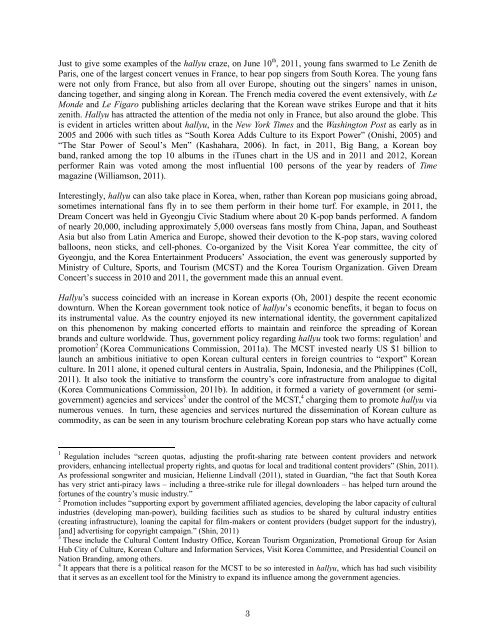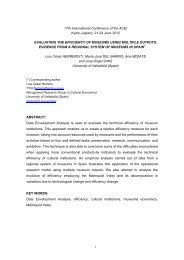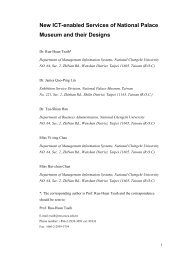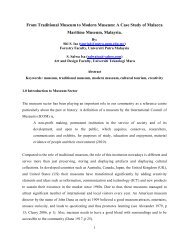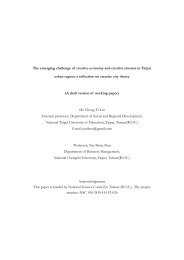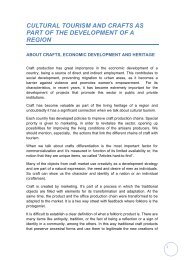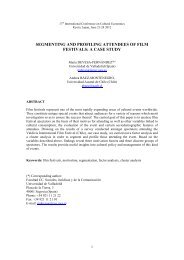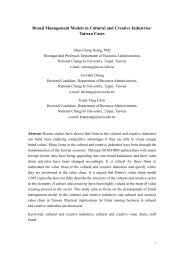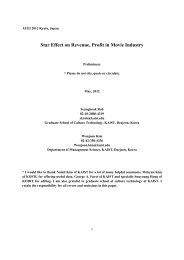The Korean Wave: Cultivating a Global Fandom by Shin-Eui Park ...
The Korean Wave: Cultivating a Global Fandom by Shin-Eui Park ...
The Korean Wave: Cultivating a Global Fandom by Shin-Eui Park ...
You also want an ePaper? Increase the reach of your titles
YUMPU automatically turns print PDFs into web optimized ePapers that Google loves.
Just to give some examples of the hallyu craze, on June 10 th , 2011, young fans swarmed to Le Zenith de<br />
Paris, one of the largest concert venues in France, to hear pop singers from South Korea. <strong>The</strong> young fans<br />
were not only from France, but also from all over Europe, shouting out the singers’ names in unison,<br />
dancing together, and singing along in <strong>Korean</strong>. <strong>The</strong> French media covered the event extensively, with Le<br />
Monde and Le Figaro publishing articles declaring that the <strong>Korean</strong> wave strikes Europe and that it hits<br />
zenith. Hallyu has attracted the attention of the media not only in France, but also around the globe. This<br />
is evident in articles written about hallyu, in the New York Times and the Washington Post as early as in<br />
2005 and 2006 with such titles as “South Korea Adds Culture to its Export Power” (Onishi, 2005) and<br />
“<strong>The</strong> Star Power of Seoul’s Men” (Kashahara, 2006). In fact, in 2011, Big Bang, a <strong>Korean</strong> boy<br />
band, ranked among the top 10 albums in the iTunes chart in the US and in 2011 and 2012, <strong>Korean</strong><br />
performer Rain was voted among the most influential 100 persons of the year <strong>by</strong> readers of Time<br />
magazine (Williamson, 2011).<br />
Interestingly, hallyu can also take place in Korea, when, rather than <strong>Korean</strong> pop musicians going abroad,<br />
sometimes international fans fly in to see them perform in their home turf. For example, in 2011, the<br />
Dream Concert was held in Gyeongju Civic Stadium where about 20 K-pop bands performed. A fandom<br />
of nearly 20,000, including approximately 5,000 overseas fans mostly from China, Japan, and Southeast<br />
Asia but also from Latin America and Europe, showed their devotion to the K-pop stars, waving colored<br />
balloons, neon sticks, and cell-phones. Co-organized <strong>by</strong> the Visit Korea Year committee, the city of<br />
Gyeongju, and the Korea Entertainment Producers’ Association, the event was generously supported <strong>by</strong><br />
Ministry of Culture, Sports, and Tourism (MCST) and the Korea Tourism Organization. Given Dream<br />
Concert’s success in 2010 and 2011, the government made this an annual event.<br />
Hallyu’s success coincided with an increase in <strong>Korean</strong> exports (Oh, 2001) despite the recent economic<br />
downturn. When the <strong>Korean</strong> government took notice of hallyu’s economic benefits, it began to focus on<br />
its instrumental value. As the country enjoyed its new international identity, the government capitalized<br />
on this phenomenon <strong>by</strong> making concerted efforts to maintain and reinforce the spreading of <strong>Korean</strong><br />
brands and culture worldwide. Thus, government policy regarding hallyu took two forms: regulation 1 and<br />
promotion 2 (Korea Communications Commission, 2011a). <strong>The</strong> MCST invested nearly US $1 billion to<br />
launch an ambitious initiative to open <strong>Korean</strong> cultural centers in foreign countries to “export” <strong>Korean</strong><br />
culture. In 2011 alone, it opened cultural centers in Australia, Spain, Indonesia, and the Philippines (Coll,<br />
2011). It also took the initiative to transform the country’s core infrastructure from analogue to digital<br />
(Korea Communications Commission, 2011b). In addition, it formed a variety of government (or semigovernment)<br />
agencies and services 3 under the control of the MCST, 4 charging them to promote hallyu via<br />
numerous venues. In turn, these agencies and services nurtured the dissemination of <strong>Korean</strong> culture as<br />
commodity, as can be seen in any tourism brochure celebrating <strong>Korean</strong> pop stars who have actually come<br />
1 Regulation includes “screen quotas, adjusting the profit-sharing rate between content providers and network<br />
providers, enhancing intellectual property rights, and quotas for local and traditional content providers” (<strong>Shin</strong>, 2011).<br />
As professional songwriter and musician, Helienne Lindvall (2011), stated in Guardian, “the fact that South Korea<br />
has very strict anti-piracy laws – including a three-strike rule for illegal downloaders – has helped turn around the<br />
fortunes of the country’s music industry.”<br />
2 Promotion includes “supporting export <strong>by</strong> government affiliated agencies, developing the labor capacity of cultural<br />
industries (developing man-power), building facilities such as studios to be shared <strong>by</strong> cultural industry entities<br />
(creating infrastructure), loaning the capital for film-makers or content providers (budget support for the industry),<br />
[and] advertising for copyright campaign.” (<strong>Shin</strong>, 2011)<br />
3 <strong>The</strong>se include the Cultural Content Industry Office, <strong>Korean</strong> Tourism Organization, Promotional Group for Asian<br />
Hub City of Culture, <strong>Korean</strong> Culture and Information Services, Visit Korea Committee, and Presidential Council on<br />
Nation Branding, among others.<br />
4 It appears that there is a political reason for the MCST to be so interested in hallyu, which has had such visibility<br />
that it serves as an excellent tool for the Ministry to expand its influence among the government agencies.<br />
3


